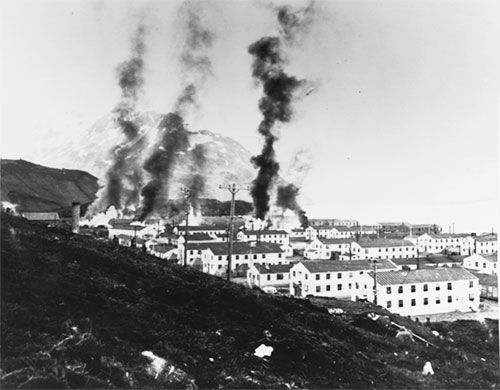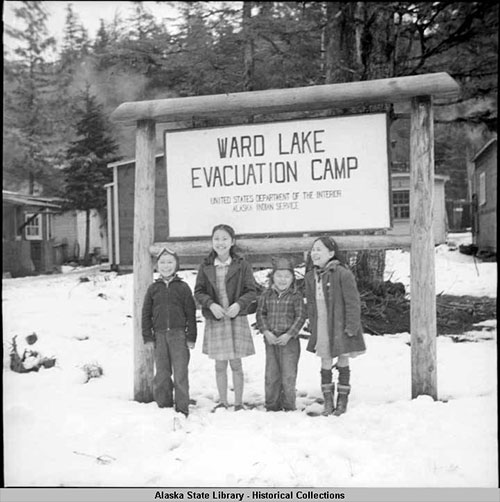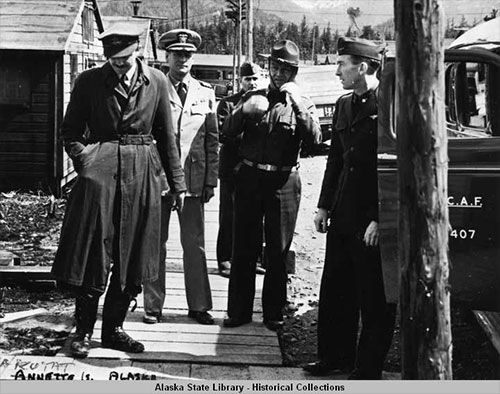World War II in KetchikanWar years were ones of uncertainty, change in the First CityBy DAVE KIFFER August 16, 2020
Approximately 850 Ketchikan residents, out of the population of slightly more than 5,000 enlisted in the conflict which involved the United States from 1941-45. Five residents of the First City - Irvin Thompson, Jerome Rice, Ragnar Myking, Robert Henderson and Awen Anderson - were killed during the war. Many others were wounded. All came back different than when they left. (See "Not All Came Back" SITNEWS, June, 26, 2020 and "Sincerely, Igloo," SITNEWS, December 7, 2011) Like many American communities, life in Ketchikan during the war was one of sacrificing for the war effort. Food and important supplies were rationed and the newspapers were filled with stories of the combat in Europe and Pacific.
(See: THE FORGOTTEN WAR: June 3, 1942 - August 1943 By JUNE ALLEN - SITNEWS, June 03, 2002.) (See: Effort to retake Attu and Kiska was 75 years ago; Ellis, Bartholomew, other locals, fought in the Aleutians - SITNEWS, May 21, 2018) But unlike most American communities, there was also fear of invasion. particularly after Japan invaded Attu and Kiska islands in the Aleutian in 1942. After the War, the US learned the Japanese had only attacked the Aleutians to draw US resources north and had no intention of advancing further on US territory, but for most of the War, Ketchikan residents remained concerned that the Japanese Army would advance further into Alaska. There were local air raid drills, plans were made to evacuate people and supplies inland and blackouts were maintained in the community at night. People who lived in Ketchikan those years, remembered decades later the uncertainty. They remembered stockpiling supplies. They remembered a palpable fear that swept the community - and all of coastal Alaska. Not long after the Pearl Harbor attack, a ski cabin high on Deer Mountain burned down and many in the community thought the fire was a sign to Japanese forces lurking offshore. During the War, the Ketchikan Coast Guard base expanded dramatically and there were also Canadian servicemen in town frequently, as the Canadian Air Force was involved in flying patrols from the Annette Island Airfield after it opened. (See "Over Here" SITNEWS, March 11, 2018)
There was another tangible example of the War, the presence of nearly 200 Aleut refugees at the old Civilian Conservation Camp at Ward Lake. Many of the Aleuts worked in Ketchikan businesses during their time here. often replacing residents who had been called elsewhere for the War effort. Several chose to remain in Ketchikan after the War. (See "A Sad Chapter of World War II" SITNEWS, June 23, 2007) Besides the Ketchikan residents who went off to fight in the War, the community was also feeling the loss of the more than 50 Japanese American residents of the community who were interned - mostly in Idaho - along with all the other Japanese residents of the West Coast. Many of the Japanese that were taken away declined to come back after the War, including several who joined the war effort despite seeing their families sent to internment camps. (See "Pat Hagiwara dies at 91, SITNEWS, July 7, 2010) Besides the conflict itself, the war years brought significant changes to the community. The faltering salmon canning industry received a brief boost when millions of cases were purchased to support the war effort. The use of timber in the war effort also put pressure on existing sources in the Lower 48 and led the US government to support opening up millions of acres in the Tongass National Forest for harvest. Alaska's position as an American territory and the relatively brief Japanese incursion into the Aleutians led the federal government to seek ways to improve access to the Last Frontier. As a result, the Alaskan Highway was built to connect the territory to the Canadian road system. The Alcan Highway significantly spurred the growth of the tourism industry in Alaska.
But even more important for Ketchikan was the construction of a large military airport on Annette Island, 20 miles south of Ketchikan. While it was not exactly what Ketchikan wanted - which was an airport closer to town - it did allow for larger land planes to arrive in the area from Seattle. Passengers would then transfer to smaller float or amphibious planes to fly from Annette to Ketchikan. No longer would a trip from Seattle to Ketchikan entail a week-long ocean voyage. Now, people could travel from Seattle to Ketchikan in a matter of hours. The First City truly began to be more connected to the Lower 48. Within a decade more people were arriving in Ketchikan via plane than by steamship. The military infrastructure - and Alaska's crucial location as a bulwark in the post-World War II "Cold War" between the United States and the Soviet Union - also helped build support for Statehood for Alaska. The end of the war, and the continued decreasing of the influence of the salmon canning industry also helped move Ketchikan firmly into the pro-statehood camp. Prior to the war, the canning industry had fought statehood because it preferred to deal with the federal government rather than a state government that would be openly opposed to the fish traps that supported the canneries. With so many Ketchikan residents spending their first significant time away from the community, the realization of the potential benefits of statehood began to take hold. (See "Ketchikan Supported Statehood, Eventually" SITNEWS, January 3, 2009) The end of the war also brought other benefits. A significant portion of the Ketchikan fishing fleet had remained in town during the war because the production of salmon was considered a national priority, in the same way that farm production in the Lower 48 was considered essential. But with a significant boost in manpower needed for an expected invasion of the Japanese Home Islands, many of the salmon fishing exemptions were cancelled and local fishermen - like my father - had been told to expect to be called up in the fall of 1945. Small boat operators were in especially short supply and were expected to be needed for the invasion. When the war ended, with the dropping of the atomic bombs on Hiroshima and Nagasaki, those plans were cancelled and those fishermen stayed home. When the hundreds of Ketchikan residents returned when the War was over, they came back to a small town that was much the same as when they left. But they now had seen much more of the world than before the war. And they would lead the change of Ketchikan from a declining salmon canning community into a timber metropolis. In 1947, the Tongass Timber Act established the long-term timber sales that allowed the pulp paper industry to take hold in Southeast Alaska and dominate the local economy for the next half century.
On the Web:
Contact Dave at dave@sitnews.us Dave Kiffer ©2020 Publication fee required. © Representations of fact and opinions in comments posted are solely those of the individual posters and do not represent the opinions of Sitnews.
|
||||||





